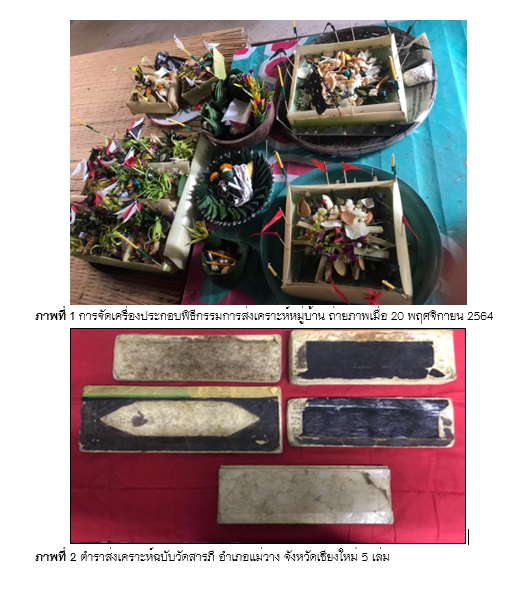Worldview Analysis of Lanna People Reflected Through “Song Kroh” Manuscript in Case Sarapi Temple, Maewang District, Chiang Mai Province
Main Article Content
Abstract
This research article aims to study the Lanna people’s worldview from Song Kroh manuscript in case Sarapi temple, Mae Wang district, Chiang Mai province. Collecting data from ancient documents in Song Kroh ceremony category, which consist of 5 issues in total, namely, Song Chon manuscript, Song Luang manuscript, Song Noppacras manuscript, Song Mahalokawut manuscript, and Song Mitfai – Song Than manuscript. The results show that Lanna people’s worldview which appears in Song Kroh manuscript in case Sarapi temple can be sorted into 3 groups. The first group is the worldview about belief. Lanna people believe in spirit, supernatural, and mysterious power. These things can cause good or bad event to person, family, and community. The second group is the worldview about religion. Lanna people believe in power of religion and gods as it can protect people from bad things, and religion can heal sick people. The last group is the worldview about tradition. Lanna people have the custom which has been inherited for long time that it becomes village’s tradition, due to Sarapi villagers’ belief about the supernatural myths.
Downloads
Article Details

This work is licensed under a Creative Commons Attribution-NonCommercial-NoDerivatives 4.0 International License.
The articles published are copyrighted by the Graduate School, Chiang Mai Rajabhat University.
The opinions expressed in each article of this academic journal are solely those of the individual authors and do not reflect the views of Chiang Mai Rajabhat University or its faculty members. The responsibility for the content of each article rests entirely with the respective authors. In the event of any errors, the authors alone are responsible for their own articles.
References
Borrisut, P. (1980). The worldview of Thai people from didactic literature in Sukothai period. Bangkok: Thai Khadi Research Institute Thammasat University. [In Thai]
Intawong, A. and Lordee, S. (2017). Worldview analysis of Lanna people reflected through The Lanna’s nouns collected from Lanna-Thai Dictionary, Mae Fah Luang Version. Journal of Liberal Arts Maejo University, 5(2), 22-41. [In Thai]
Kaenkarn, S. (2005). Thianwan’s world views. (Master of Arts, Thai Srinakharinwirot University). [In Thai]
Krumram, P. (2013). Education the worldview in junior high school Thai subject graded readers. Bangkok: Ramkhamhaeng University. [In Thai]
Lordee, S. (2021). Lanna spirit terms: Existence and Lanna worldviews. Journal of Liberal Arts, Thammasat University, 21(1), 396-420. [In Thai]
Nanti, P. (2012). Songkroh-Songnam the ceremony of dispelling a spirit. Retrieved from https://forums.chiangraifocus.com/?topic=286210.0#gsc.tab=0 [In Thai]
Somboonanake, S. (2000). The accumulation and service manuscript Chiang Mai University library. Retrieved from https://journal.oas.psu.ac.th/index.php/asj/article/viewFile/440/412 [In Thai]
Songchon. (n.d.). Songchon Manuscript. Sarapi Temple.
Songkiw. (n.d.). Songluang Manuscript. Sarapi Temple.
Songmahalokawut. (n.d.). Songmitfai-songthan Manuscript. Sarapi Temple.
Songmitfai. (n.d.). Songmitfai-Songthan Manuscript. Sarapi Temple.
Songnoppacras. (n.d.). Songnoppacras Manuscript. Sarapi Temple.
Songphihaphikrian. (n.d.). Songluang Manuscript. Sarapi Temple.
Songsoon. (n.d.). Songluang Manuscript. Sarapi Temple.
Songthan. (n.d.). Songmitfai-Songthan Manuscript. Sarapi Temple.
Suprom, T. (2006). Construction of local wisdom learning resources entitled Phithii Songkroh of Pathang Community, Khunkhuan Sub-District, Pong District, Phayao Province. (Master of Education, Teaching Thai, Chiangmai University). [In Thai]
Thailand Cultural Encyclopedia Foundation Thai The Siam Commercial Bank. (1999a). Thai northern cultural encyclopaedia 12: Lii – Songchon. Bangkok: Siam Management. [In Thai]
Thailand Cultural Encyclopedia Foundation Thai The Siam Commercial Bank. (1999b). Thai northern cultural encyclopaedia 14: Songthan– Suwannajakawattiraj. Bangkok: Siam Management. [In Thai]
Thamthi, S. (2017). Songkroh. Retrieved from https://art-culture.cmu.ac.th/Lanna/articleDetail/1422 [In Thai]
Vachiro, Phr. (2010). A critical study of the Buddhist doctrines and world view on Prayakhankhak E-San Folk-Talks. (Master of Arts, Buddhist Studies, Mahachulalongkornrajavidyalaya University). [In Thai]


